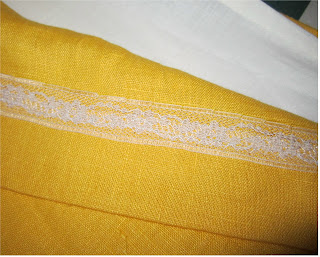 |
| Butterick 5450 |
It has just been a week and a day since I have sewn with this pattern and here I am creating another version. In an effort to reduce my fabric stash, I dug through my pile and found a yard of cotton eyelet in ivory and a European linen in "electric lemon" both purchased last year from Fabric.com. I also found enough cotton batiste to line the whole dress.
 |
| L-R: Cotton Blend Batiste, European Linen 4.8 oz, Alix Eyelet. |
I decided to use the eyelet for the bodice. However, it was not only lightweight and sheer, the nature of the eyelet holes meant I had to make sure the seams were neatly finished so I opted for French seams.
 |
| To achieve this French seam, I sewed the two pieces wrong sides together in a 1/4" seam, ironed the seam flat to one side, folded the sewn pieces right sides together then sewed the final 3/8" seam. |
 |
| Here is the bodice and its lining. |
In the original pattern, only the bodice is lined. Since the linen was a bit sheer, I opted to add my own lining. I just duplicated the main fabric skirt pieces using the lining fabric and then attached them together at the bodice seam and side seam (where the zipper opening was).
 |
| This time, I also didn't use invisible zipper as I decided to recycle a regular zipper from an unfinished project. |
I used a lace hem tape for the skirt hem.
I just used narrow hem for the skirt lining.
Nothing screams summer like ivory, eyelet and linen!
 |
| I found this pretty crochet trim in my stash and still deciding on whether to use it or not. |
Here is a comparison of the two dresses from the same pattern.
Although I love both these dresses, I can predict the linen will drive me crazy as it wrinkles like mad.















































